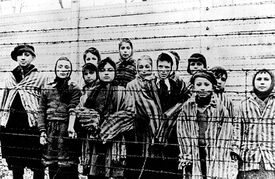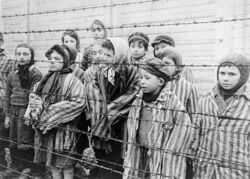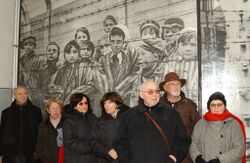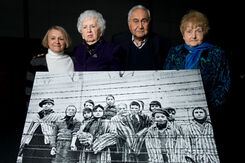Bracha Katz
Bracha Katz / Berta Weinhaber (F / Slovakia, 1930), Holocaust survivor.
Biography
Auschwitz Picture
She is present in an iconic Auschwitz picture, that depicts 13 child survivors, shortly after the liberation of the camp. All of them have been identified. From left to right they are:
- (1) Tomy Shacham / Tomy Schwarz (M / Slovakia, 1933)
- (2) Miriam Friedman / Miriam Ziegler (F / Poland, 1933)
- (3) Pessa Balter / Paula Lebovics (F / Poland, 1933)
- (4) Ruth Muschkies / Ruth Webber (F / Poland, 1935)
- (5) Bracha Katz / Berta Weinhaber (F / Slovakia, 1930)
- (6) Erika Dohan / Erika Winter (F / Czechia, 1931)
- (7) Marta Wise / Marta Slonim (F / Slovakia, 1934)
- (8) Eva Slonim / Eva Weiss (F / Slovakia, 1931)
- (9) Gabor Hirsch (M / Poland, 1929)
- (10) Gabriel Neumann / Gabriel Nejman (M / Czechia, 1937-2012)
- (11) Shmuel Schelach / Robert Schlesinger (M / Czechia, 1934-2006)
- (12 & 13) Eva & Miriam Mozes / Eva Kor (F / Romania, 1934-2019) and Miriam Zieger (F / Romania, 1934-1993).
Bracha Katz was among the seven children who reunited on 27 January 2005 in the ceremony in Poland marking 60 years since the liberation of Auschwitz (photograph by Dalit Shacham). The group included (from left to right): Tomy Shacham (1); Erika Dohan (6); Marta Wise (7); Eva Slonim (8); Shmuel Schelach (11); Gabriel Neumann (10); and Bracha Katz (5).
In separate reunion four other survivors gathered in Krakow, Poland on 26 January 2015, at the invitation of the USF Shoah Foundation, on the eve of the 70th anniversary of the liberation of the death camp. The Group included (from left to right): Paula Lebovics (3), Miriam Ziegler (2), Gabor Hirsch (9), and Eva Kor (12). (Photo by Ian Gavan/Getty Images).
USF Shoah Foundation
Like several other children in the photograph, Bracha Katz (formerly Berta Weinhaber) avoided the gas chamber of Auschwitz by being one of the few selected for Dr. Josef Mengele’s medical experiments, but she was one of even fewer who survived the experiments and deplorable conditions of the camp.
Bracha was the second youngest of six siblings, born March 28, 1930, in Bratislava, Czechoslovakia. Her father was descended from a long line of rabbis and was the head of the Jewish community in Bratislava. In 1942, Bracha’s three older brothers were sent to the Majdanek concentration camp, and in 1944, the rest of the family was forced into the Sered concentration camp. Just two months later, Bracha, her younger brother Adolf, older sister Rachel, and their parents were sent by cattle car to Auschwitz-Birkenau. Bracha remembers the car being so crowded she couldn’t breathe.
When they arrived on the selection platform at Auschwitz, a Jewish kapo, or supervisor, told Bracha to pretend that she and Adolf were twins, even though he was two years younger. As “twins,” they were selected for Mengele’s medical experiments block. Though Bracha did not often reveal much about what happened to her there, she remembers vividly her friendship with Eva Slonim, who is also in the photograph. Eva was also from Bratislava and the two were the oldest children in the block so they would often take care of the younger children. Using their fingers in the air, Bracha and Eva would write songs. Sixty years later, they reunited in Poland and were still able to sing a song they had written together in the camp.
Adolf became very sick and was coughing. One day, the Germans took him away and Bracha never saw him again. Someone told her that he had been shot.
Bracha survived until the Soviet Army liberated Auschwitz on Jan. 27, 1945. A man named Kon, who was a relative of Bracha’s took her, Eva, Eva’s sister Marta, and some other children to a school in Krakow to recover. Bracha continued on to Bratislava, but she did not find any family there, so she went with Eva and Marta to a hostel in the Tatra mountains. Eventually, a cousin found her there and took her to Bratislava to reunite with her mother and sister Rachel, who had been at a German arms factory.
The three planned to go to Israel together, but Bracha’s mother died of a heart attack two months before they were scheduled to depart, in 1949. Bracha and Rachel continued on, and one year later Bracha met her husband Ze’ev Katz. Bracha and Ze’ev have two daughters, Pnina and Lea, six grandchildren and one great-grandchild.



